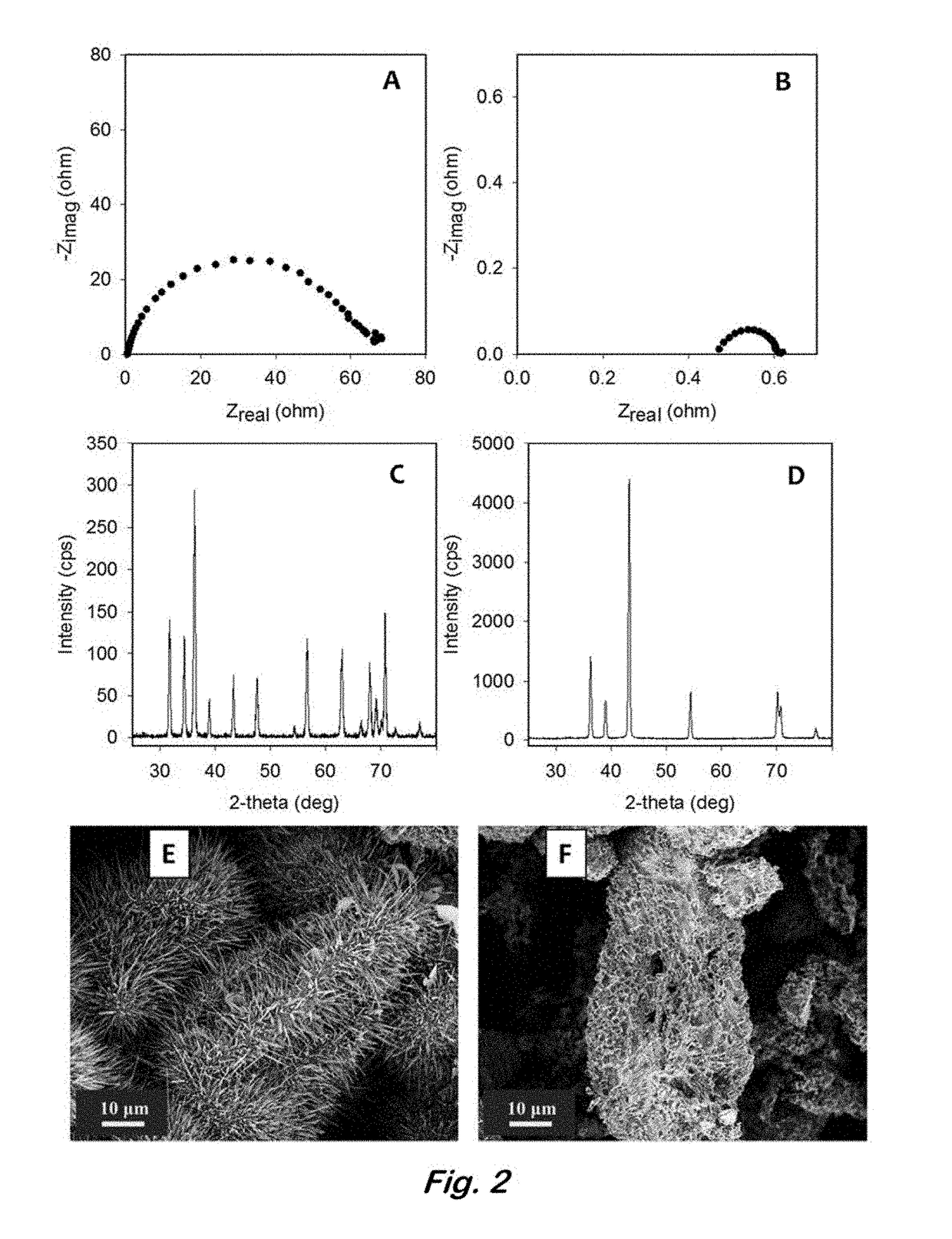Zinc Electrodes for Batteries
a zinc electrode and battery technology, applied in the field of porous zinc electrodes, can solve the problems of limited rechargeability, manufacturing cost, and limited application and achieve the effects of reducing the cost of manufacturing, reducing the use of zinc-air, and reducing the use of li-ion-based energy storag
- Summary
- Abstract
- Description
- Claims
- Application Information
AI Technical Summary
Benefits of technology
Problems solved by technology
Method used
Image
Examples
example 1
Fabrication of Monolithic Zinc Sponges
[0043]A typical preparation of zinc sponge electrodes begins with the formation of an emulsion of zinc powder in water and decane. In a small beaker or scintillation vial, 6.0 g of zinc powder that also contains 300-ppm indium and 285-ppm bismuth (as-received from Grillo-Werke AG) was added. The indium and bismuth additives are necessary to raise the overpotential for hydrogen evolution in alkaline electrolytes, while eliminating the need for toxic additives such as lead and mercury (Glaeser, U.S. Pat. No. 5,240,793). Water (1.027 mL) and decane (2.282 mL) were added along with an emulsifier, sodium dodecyl sulfate (6.3 mg) and emulsion stabilizer, carboxymethylcellulose (0.253 g). The use of these ingredients in the formation of zinc emulsions that are subsequently used to make zinc electrodes has been described previously (Drillet et al., “Development of a Novel Zinc / Air Fuel Cell with a Zn Foam Anode, a PVA / KOH Membrane, and a MnO2 / SiOC-based...
example 2
Zinc Sponges as a Negative Electrode in Zinc-Air Batteries
[0044]The intentional introduction of oxide to the zinc sponges enhances the mechanical integrity, allowing them to be routinely handled with decreased risk of fracture; however, a layer of oxide on the zinc lowers the initial capacity upon discharge and introduces contact resistance when assembling the zinc-containing cell (see Nyquist plots from electrochemical impedance spectroscopy (EIS) in FIG. 2A). In order to electrochemically reduce the ZnO coating, the sponge is used as part of the working electrode in a half-cell, three-electrode configuration with a Pt counter electrode and zinc quasi-reference electrode in 6 M KOH. A zinc sponge was placed in an envelope of tin-coated-copper mesh to form the working electrode. (Tin contacts were used because tin is galvanically compatible with zinc and corrosion of the electrode is suppressed that would otherwise be rampant with other current collectors (e.g., nickel, copper, etc....
example 3
Reversibility of Zinc Sponge Anodes
[0047]In order to study the reversibility of the 3D zinc sponge in a battery configuration, without the requirement of having an optimized cathode (e.g., bifunctionally catalytic for the ORR or OER), a symmetrical electrochemical cell containing an all-metal Zn sponge versus a Zn / ZnO sponge separated by an aqueous-compatible separator was used. The Zn / ZnO sponge was prepared by electroreducing some of the ZnO present from the post-heated sponge by applying −50 mV versus zinc for 10-min increments. The EIS and the OCP were measured after each cycle. The reduction of this sponge was terminated when the RCT in the EIS fell below 0.5 Ωcm−2, but the OCP remained greater than 30 mV vs. Zn, indicating high conductivity throughout the sponge network, yet ZnO remained. A second post-heated sponge was reduced at −50 mV versus Zn for 30-min increments as described in Example 2 until it was fully reduced to all metal Zn sponge with an OCP very close to 0 mV vs...
PUM
| Property | Measurement | Unit |
|---|---|---|
| temperature | aaaaa | aaaaa |
| temperature | aaaaa | aaaaa |
| discharge current densities | aaaaa | aaaaa |
Abstract
Description
Claims
Application Information
 Login to View More
Login to View More - R&D Engineer
- R&D Manager
- IP Professional
- Industry Leading Data Capabilities
- Powerful AI technology
- Patent DNA Extraction
Browse by: Latest US Patents, China's latest patents, Technical Efficacy Thesaurus, Application Domain, Technology Topic, Popular Technical Reports.
© 2024 PatSnap. All rights reserved.Legal|Privacy policy|Modern Slavery Act Transparency Statement|Sitemap|About US| Contact US: help@patsnap.com










